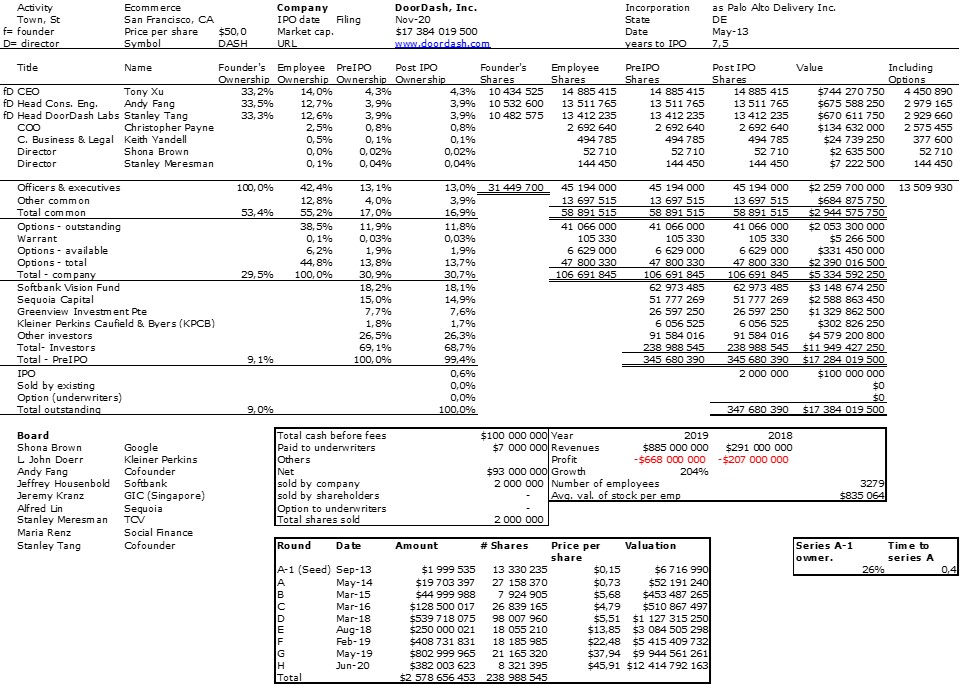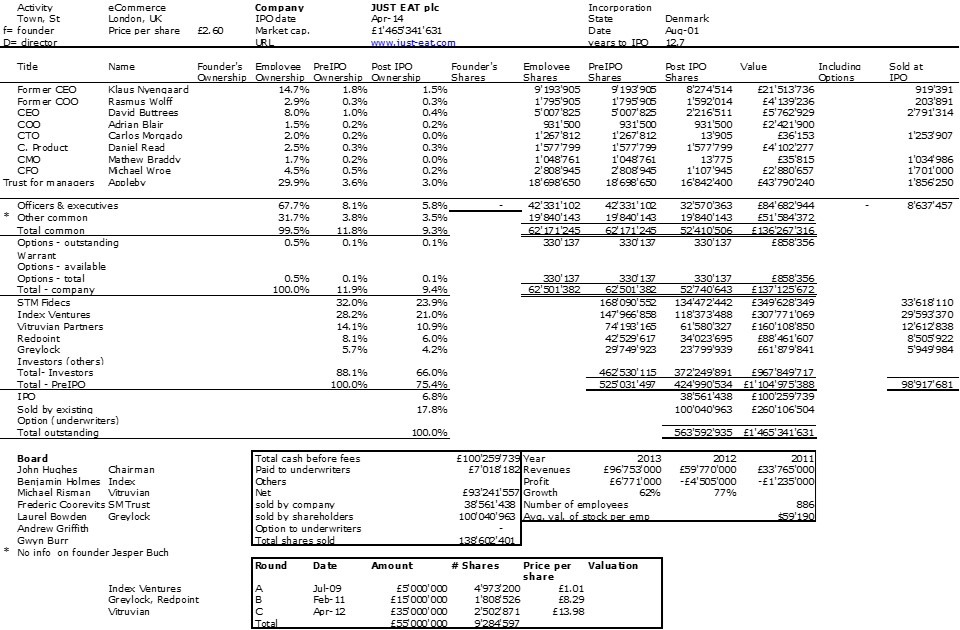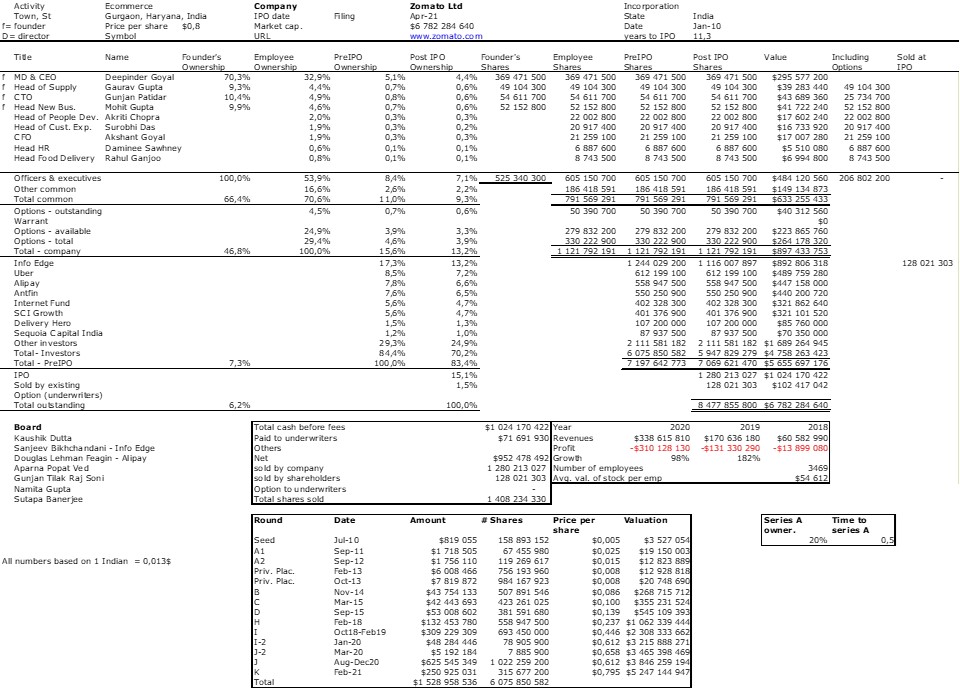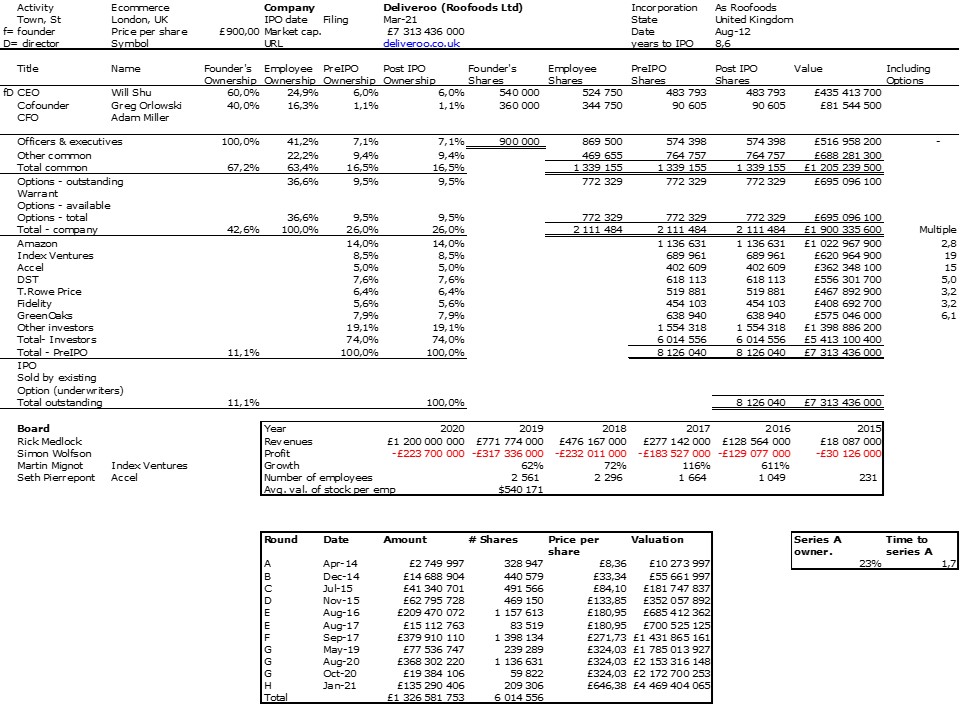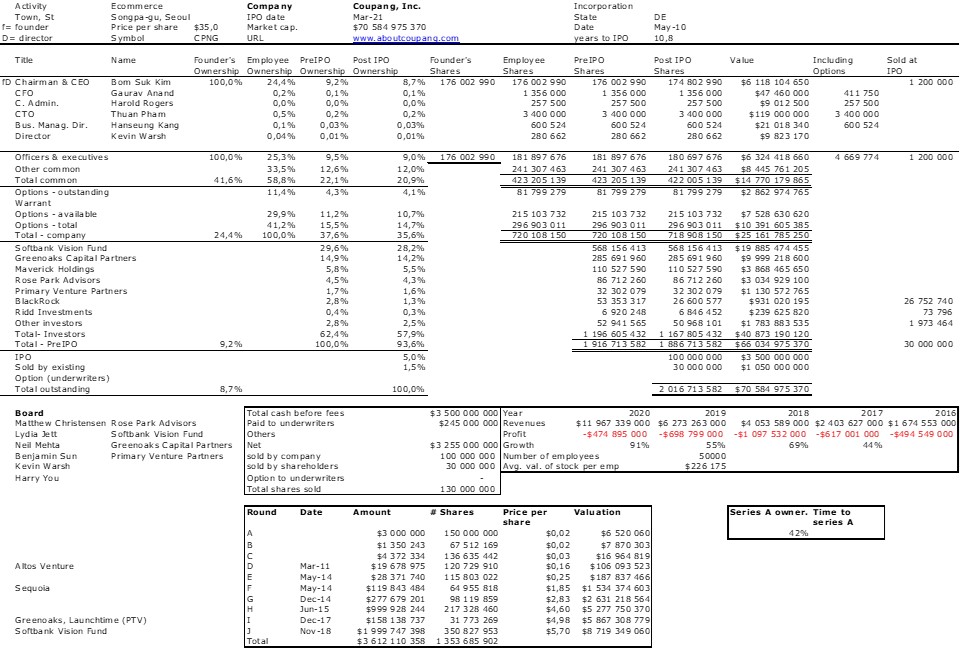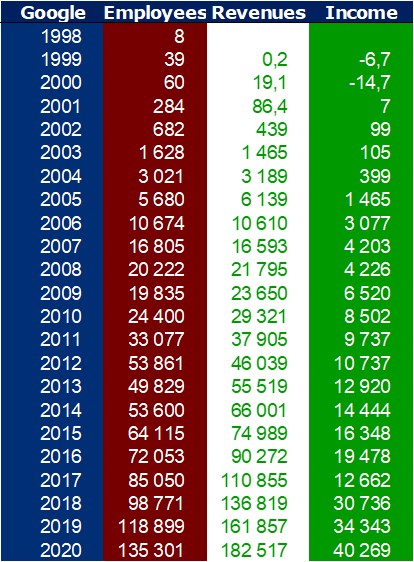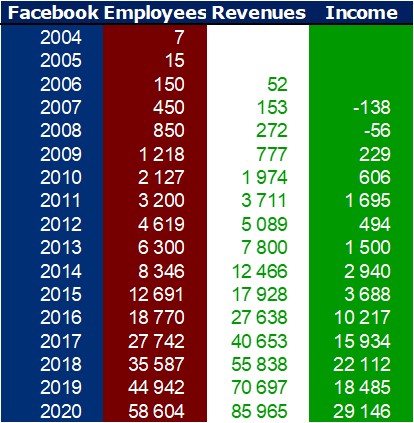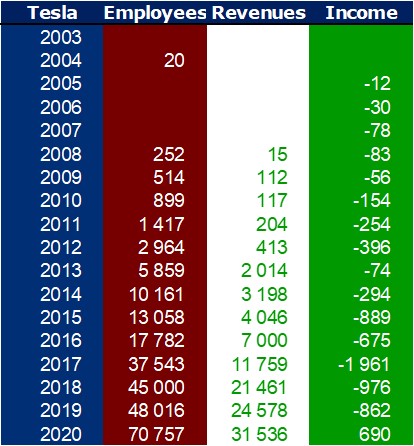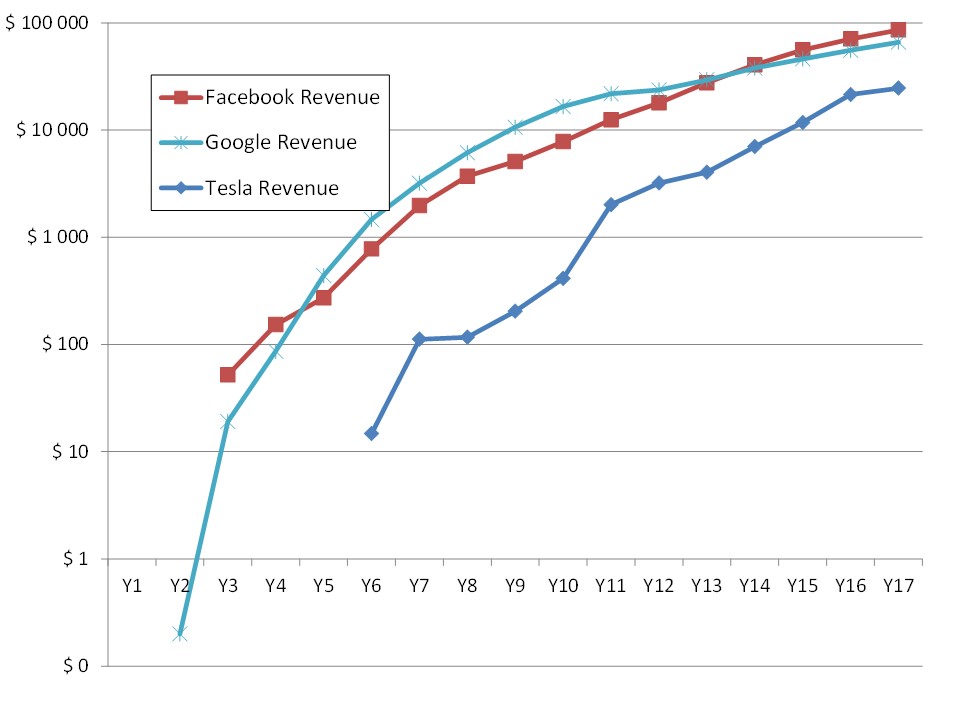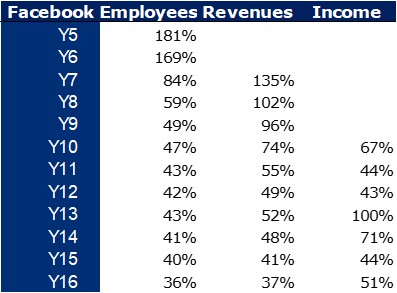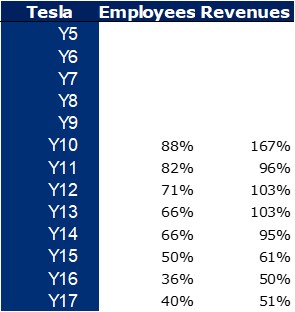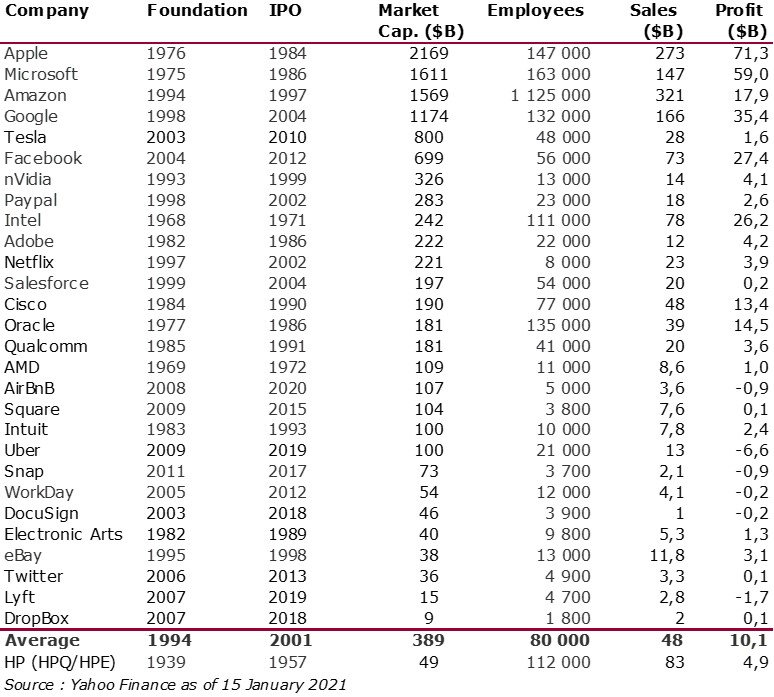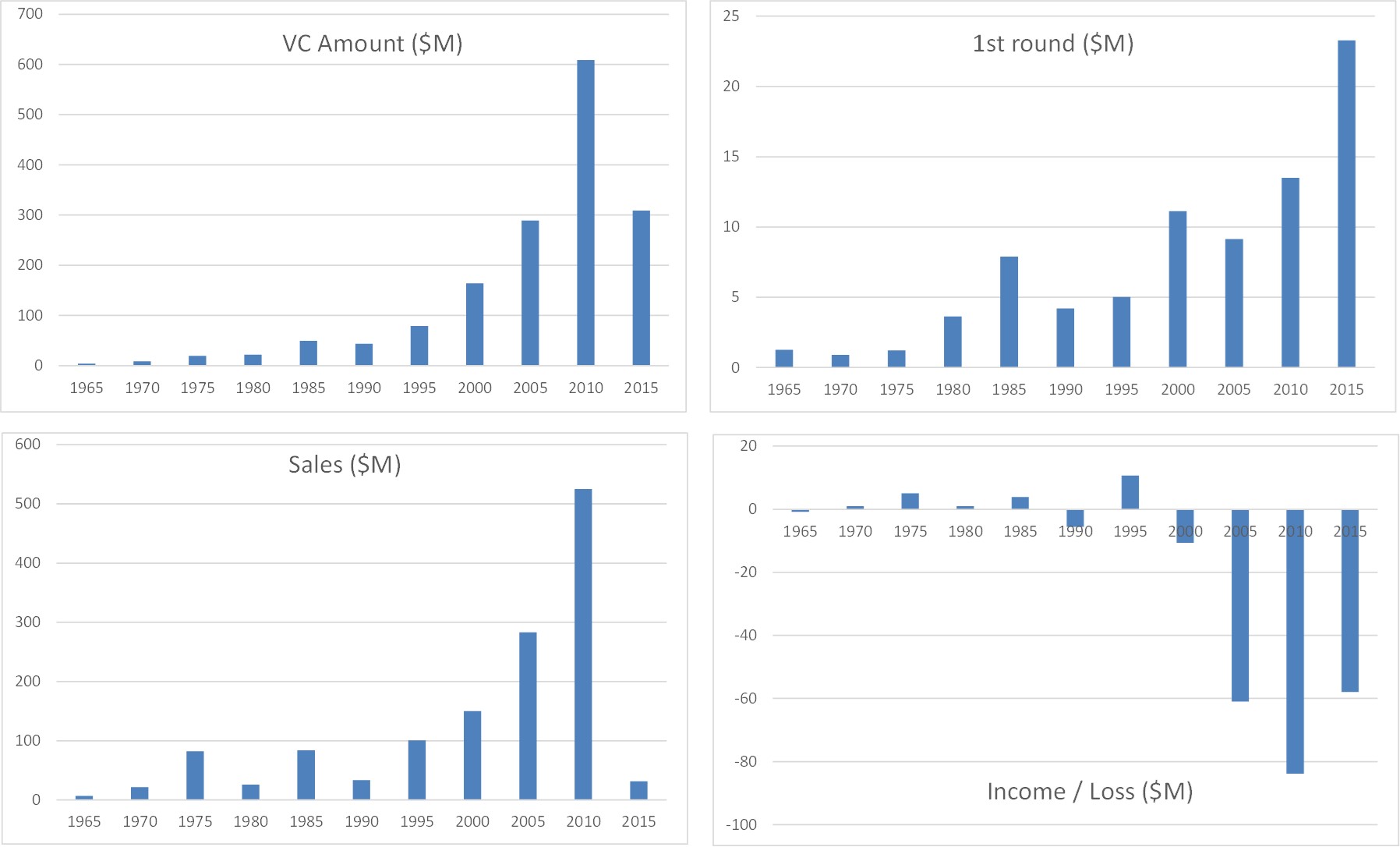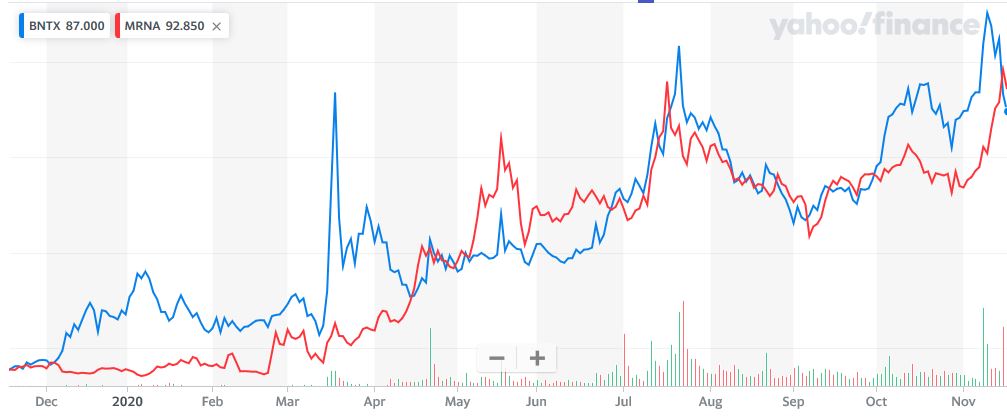I was motivated a few days ago to look at the work I have been doing for years on public tech. companies, their cap. tables, their overall financial performance. If you do not know what I am talking about, you can have a look at my past analyses on 600, then 700 companies through the tag 600 (former) startups. I’ve now 787 such cap. tables.
It’s been known that there are differences with fields such as biotech. vs. software/internet. About biotech, check Are Biotechnology Startups Different? Regarding software, and more specifically Internet or ecommerce companies, I have not done a similar analysis but I began to notice a while ago that these companies were also money-losing companies at IPO. In the past, you were only going public in IT when you were beginning to be profitable. This was more than 20 years ago! The recent argument for going public while losing money was that these companies would make a profit once they have reached a threshold in size. Amazon was not profitable for many years after its IPO.
But isn’t that argument flawed? Will Uber or AirBnB and similar platform companies ever make a profit? Too early to say and the future is unpredictable. But I thought I would look at the current situation of my 787 companies and have a quick look. So before studying the profit profile of IT companies (this will be in part 2, my next post), here are the basics. There is a total of 435 public companies – 353 companies have been acquired, liquidated (315) and a few are still private (37). My next post should follow soon.
| Market Cap | # | $B |
| $1T | 4 | 7’253 |
| $100B | 17 | 5’274 |
| $10B | 88 | 3’273 |
| $1B+ | 168 | 623 |
| <$1B | 150 | 55 |
| Total | 427 | 16’478 |
These numbers again show the power law distribution (and not Gaussian) and here is the long list of names for those interested:
| $1,000B+ | $100B+ | $10B+ | $1B+ |
| Amazon | Adobe Inc. | 10x Genomics, Inc. | 1-800-FLOWERS.COM, Inc. |
| Apple | Alibaba Group | Advanced Micro Devices, Inc. | 1Life Healthcare, Inc. |
| Amgen Inc. | Adyen N.V. | 2U, Inc. | |
| Microsoft | Cisco Systems, Inc. | Affirm Holdings, Inc. | 8×8, Inc. |
| Facebook, Inc. | Airbnb, Inc. | 908 Devices Inc. | |
| Intel Corporation | Akamai Technologies, Inc. | AbCellera Biologics Inc. | |
| JD.com, Inc. | Alnylam Pharmaceuticals, Inc. | ACADIA Pharmaceuticals Inc. | |
| Netflix, Inc. | ANSYS, Inc. | Acceleron Pharma Inc. | |
| NVIDIA Corporation | AppLovin Corporation | Accolade, Inc. | |
| Oracle Corporation | Arista Networks, Inc. | Adaptive Biotechnologies Corp | |
| PayPal Holdings, Inc. | Atlassian Corporation Plc | Agios Pharmaceuticals, Inc. | |
| Pinduoduo Inc. | Avalara, Inc. | Alector, Inc. | |
| salesforce.com, inc. | Baidu, Inc. | Aligos Therapeutics, Inc. | |
| Shopify Inc. | Bilibili Inc. | Allogene Therapeutics, Inc. | |
| Square, Inc. | Bill.com Holdings, Inc. | AlloVir, Inc. | |
| Tesla, Inc. | BioNTech SE | American Well Corporation | |
| Xiaomi Corporation | Check Point Software | Amyris, Inc. | |
| Chegg, Inc. | Anaplan, Inc. | ||
| Citrix Systems, Inc. | Arcutis Biotherapeutics, Inc. | ||
| Cloudflare, Inc. | Asana, Inc. | ||
| Coinbase Global, Inc. | Asetek A/S | ||
| Coupang, Inc. | Avast Plc | ||
| CrowdStrike Holdings, Inc. | Axonics, Inc. | ||
| CureVac N.V. | Beam Therapeutics Inc. | ||
| Datadog, Inc. | Berkeley Lights, Inc. | ||
| Delivery Hero SE | Beyond Meat, Inc. | ||
| DocuSign, Inc. | BigCommerce Holdings, Inc. | ||
| DoorDash, Inc. | BlackBerry Limited | ||
| Dropbox, Inc. | Bloom Energy Corporation | ||
| eBay Inc. | bluebird bio, Inc. | ||
| Elastic N.V. | Blueprint Medicines Corp | ||
| Electronic Arts Inc. | Box, Inc. | ||
| Enphase Energy, Inc. | C3.ai, Inc. | ||
| Equinix, Inc. (REIT) | C4 Therapeutics, Inc. | ||
| F5 Networks, Inc. | Ciena Corporation | ||
| Farfetch Limited | Cimpress plc | ||
| Fortinet, Inc. | Cirrus Logic, Inc. | ||
| Garmin Ltd. | Compass, Inc. | ||
| GoDaddy Inc. | ContextLogic Inc. | ||
| HelloFresh SE | Corcept Therapeutics | ||
| Horizon Therapeutics | Coursera, Inc. | ||
| HubSpot, Inc. | CRISPR Therapeutics AG | ||
| Illumina, Inc. | Criteo S.A. | ||
| Intuitive Surgical, Inc. | CyberArk Software Ltd. | ||
| Jazz Pharmaceuticals plc | Deliveroo plc | ||
| Lam Research Corporation | Denali Therapeutics Inc. | ||
| Logitech International S.A. | Design Therapeutics, Inc. | ||
| Lyft, Inc. | Dicerna Pharmaceuticals, Inc. | ||
| Marvell Technology, Inc. | DigitalOcean Holdings, Inc. | ||
| Micron Technology, Inc. | Domo, Inc. | ||
| Moderna, Inc. | Eargo, Inc. | ||
| NIO Inc. | Edgewise Therapeutics, Inc. | ||
| Nuance Communications, Inc. | Editas Medicine, Inc. | ||
| Okta, Inc. | Enanta Pharmaceuticals, Inc. | ||
| Palantir Technologies Inc. | Eventbrite, Inc. | ||
| Palo Alto Networks, Inc. | Exelixis, Inc. | ||
| Pinterest, Inc. | Extreme Networks, Inc. | ||
| Procore Technologies, Inc. | Fastly, Inc. | ||
| Qorvo, Inc. | Fate Therapeutics, Inc. | ||
| QuantumScape Corporation | FireEye, Inc. | ||
| Roblox Corporation | Five Prime Therapeutics, Inc. | ||
| Seagen Inc. | Fiverr International Ltd. | ||
| Snap Inc. | Flywire Corporation | ||
| Snowflake Inc. | FormFactor, Inc. | ||
| SolarEdge Technologies, Inc. | Generation Bio Co. | ||
| Splunk Inc. | Gevo, Inc. | ||
| Spotify Technology S.A. | Glaukos Corporation | ||
| StoneCo Ltd. | Globant S.A. | ||
| Synopsys, Inc. | GoPro, Inc. | ||
| Teladoc Health, Inc. | Gracell Biotechnologies Inc. | ||
| Tuya Inc. | Groupon, Inc. | ||
| Twilio Inc. | Grubhub Inc. | ||
| Twitter, Inc. | Guidewire Software, Inc. | ||
| Uber Technologies, Inc. | Idorsia Ltd | ||
| Unity Software Inc. | Inari Medical, Inc. | ||
| Upstart Holdings, Inc. | Infinera Corporation | ||
| VeriSign, Inc. | InMode Ltd. | ||
| Vipshop Holdings | Inogen, Inc. | ||
| Wayfair Inc. | Inphi Corporation | ||
| Workday, Inc. | Inspire Medical Systems, Inc. | ||
| XPeng Inc. | Instil Bio, Inc. | ||
| Yandex N.V. | Intellia Therapeutics, Inc. | ||
| Zalando SE | iRobot Corporation | ||
| Zendesk, Inc. | Ironwood Pharmaceuticals, Inc. | ||
| Zillow Group, Inc. | JFrog Ltd. | ||
| Zoom Video | JOYY Inc. | ||
| Zscaler, Inc. | Juniper Networks, Inc. | ||
| Zynga Inc. | Karuna Therapeutics, Inc. | ||
| Keros Therapeutics, Inc. | |||
| Kymera Therapeutics, Inc. | |||
| Lemonade, Inc. | |||
| LendingClub Corporation | |||
| MacroGenics, Inc. | |||
| MaxLinear, Inc. | |||
| Medallia, Inc. | |||
| Mimecast Limited | |||
| Model N, Inc. | |||
| Momo Inc. | |||
| NanoString Technologies, Inc. | |||
| Natera, Inc. | |||
| nCino, Inc. | |||
| New Work SE | |||
| nLIGHT, Inc. | |||
| Nutanix, Inc. | |||
| Olo Inc. | |||
| ON24, Inc. | |||
| Opendoor Technologies Inc. | |||
| Oscar Health, Inc. | |||
| Overstock.com, Inc. | |||
| PagerDuty, Inc. | |||
| Phreesia, Inc. | |||
| Pluralsight, Inc. | |||
| Poshmark, Inc. | |||
| Power Integrations, Inc. | |||
| Prelude Therapeutics Inc | |||
| PTC Therapeutics, Inc. | |||
| PubMatic, Inc. | |||
| Pulmonx Corporation | |||
| Pure Storage, Inc. | |||
| QAD Inc. | |||
| Qualys, Inc. | |||
| Quotient Technology Inc. | |||
| Rambus Inc. | |||
| Rapid7, Inc. | |||
| Recursion Pharmaceuticals, Inc. | |||
| Redfin Corporation | |||
| Revolution Medicines, Inc. | |||
| Ribbon Communications Inc. | |||
| Rubius Therapeutics, Inc. | |||
| Sana Biotechnology, Inc. | |||
| Sangamo Therapeutics, Inc. | |||
| Schrödinger, Inc. | |||
| Seer, Inc. | |||
| Silicon Laboratories Inc. | |||
| Smartsheet Inc. | |||
| Soitec S.A. | |||
| Sonos, Inc. | |||
| Sprout Social, Inc. | |||
| Squarespace, Inc. | |||
| Stoke Therapeutics, Inc. | |||
| STORE Capital Corporation | |||
| Sumo Logic, Inc. | |||
| Sunrun Inc. | |||
| Supernus Pharmaceuticals, Inc. | |||
| SVMK Inc. | |||
| Swissquote Group Holding Ltd | |||
| Synaptics Incorporated | |||
| Talend S.A. | |||
| Tandem Diabetes Care, Inc. | |||
| Tenable Holdings, Inc. | |||
| The Honest Company, Inc. | |||
| ThredUp Inc. | |||
| Trustpilot Group plc | |||
| Turning Point Therapeutics, Inc. | |||
| Upland Software, Inc. | |||
| Upwork Inc. | |||
| Vaxcyte, Inc. | |||
| Veracyte, Inc. | |||
| Viasat, Inc. | |||
| Vroom, Inc. | |||
| Xencor, Inc. | |||
| Xperi Holding Corporation | |||
| Yelp Inc. | |||
| Yext, Inc. | |||
| Zhihu Inc. | |||
| ZipRecruiter, Inc. | |||
| Zuora, Inc. | |||
| Zymergen Inc. |



